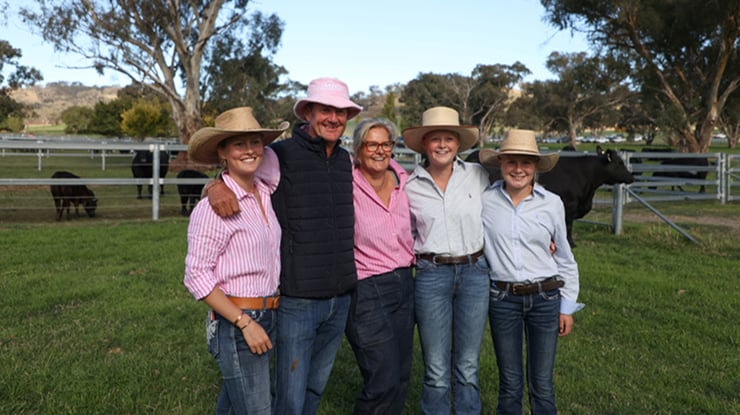 Millie, Ross, Dimity, Olivia and Twiggy Thompson after their record-breaking cow sale on 20 April 2023 at 'Goonamurrah'. Image: Ben Simpson, OGA Creative
Millie, Ross, Dimity, Olivia and Twiggy Thompson after their record-breaking cow sale on 20 April 2023 at 'Goonamurrah'. Image: Ben Simpson, OGA Creative
For Ross and Dimity Thompson, the success of their NSW stud, Milah Murrah Angus, relies on a balance between 'looking under the hood' at their livestock's genetics and careful visual inspection of each animal they introduce to the herd.
The stud, based at their Bathurst property 'Goonamurrah', was founded in 1969 by Ross's parents Wyatt and Winsome Thompson. Ross and Dimity took over the stud in 2003.
A loyal customer base and standout sales results – with Milah Murrah achieving the highest averaging beef bull sale in Australia in all but three years since 2011 – is testament to their breeding success.
Visual inspection
On top of objectively evaluating the sires he invests in, Ross stands firmly behind the merits of physical inspection.
"No matter how much technological advancement we make as an industry, the time-tested basics of cattle breeding mean that I must see firsthand everything we use in the herd. This lowers the margin of error in the phenotypic outcome of our cattle," he said.
Ross's three fundamental traits for cow/calf profitability are:
- a fertile cow that rebreeds each year
- a cow that holds her condition easy in drought
- a cow that weans a heavy calf which will grow out to a point, but not with an excessive frame.
Multi-breed genetic evaluations Multi-breed evaluations allow comparison of animals' genetic merit regardless of breed, allowing identification of the right animal for the right purpose. "Notwithstanding the various breed societies' intellectual property rights associated with EBVs, I don't think multi-breed EBVs are something that hold any fear," Ross said. "My guess is multi-breed EBVs will highlight the relative strengths (and weaknesses) of the individual beef breeds. "From an Angus perspective, I suspect it will lead to more focus on, and appreciation of, the all-round qualities of the breed. I don't think it will precipitate a mass rush into cross-breeding. It will just give beef producers additional tools to enhance genetic understanding." |
Stewards of the land
Ross and Dimity have moved increasingly towards a regenerative approach to farming.
"The cattle provide the income so we can improve the land. We fence off the fragile parts of the property and we ramp up production on the more resilient areas," Ross said.
Productivity improvements include an extensive, targeted fertiliser program based on chook manure, lime and gypsum.
A comprehensive realignment of the fencing infrastructure on Goonamurrah (increasing paddock numbers from 40 to 60 across 951ha), coupled with development of an extensive reticulated water network, has seen pasture quality and sward density increase dramatically.
"We are now able to implement many of the principles of time-controlled grazing, with denser stocking rates for shorter periods and increased rest periods," Ross said.
"The impact on weed reduction has been tremendous, with a much higher percentage of desirable species in the pasture."
Carbon sequestration makes sense
In 2022, the Thompsons contracted the entirety of Goonamurrah with the Clean Energy Regulator under a carbon sequestration contract.
"Many people are reticent to commit to carbon programs, usually due to the uncertainty surrounding the whole sector, but from my point of view there's nothing to fear from being contracted to the regulator," Ross said
"Nothing we're doing is contrary to what I'd want to be doing anyway. We're improving the water, nutrient and carbon cycles of our land – everyone is winning."
With several environmental awards under their belt, the couple plan to continue rejuvenating their land for the benefit of future generations and the ongoing productivity of their business.
Four ways the Thompsons are caring for the environment
|






